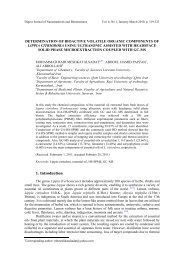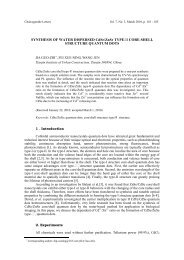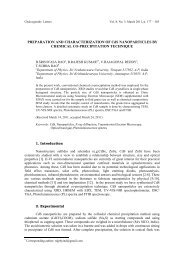GREEN SYNTHESIS OF SILVER NANOPARTICLES USING ...
GREEN SYNTHESIS OF SILVER NANOPARTICLES USING ...
GREEN SYNTHESIS OF SILVER NANOPARTICLES USING ...
You also want an ePaper? Increase the reach of your titles
YUMPU automatically turns print PDFs into web optimized ePapers that Google loves.
Digest Journal of Nanomaterials and Biostructures Vol. 6, No 1, January-March 2011, p. 181 - 186<br />
<strong>GREEN</strong> <strong>SYNTHESIS</strong> <strong>OF</strong> <strong>SILVER</strong> <strong>NANOPARTICLES</strong> <strong>USING</strong> OCIMUM LEAF<br />
EXTRACT AND THEIR CHARACTERIZATION<br />
K. MALLIKARJUNA a , G. NARASIMHA b , G. R. DILLIP a , B. PRAVEEN b ,<br />
B. SHREEDHAR c , C. SREE LAKSHMI c , B. V. S. REDDY c , B. DEVA PRASAD RAJU a*<br />
a Department of Physics, Sri Venkateswara University, Tirupati-517502, India.<br />
b Department of Virology, Sri Venkateswara University, Tirupati-517502, India.<br />
c Indian Institute of Chemical Technology, Hyderabad-500007, India.<br />
The metallic nanoparticles have great attention of Chemists, Physists, Biologists and Engineers who<br />
wish to use them for development of new generation nanodevices. In this present study silver<br />
nanoparticles were synthesized from aqueous silver nitrate (1mM) through a simple and ecofriendly<br />
route using leaf broth of Ocimum sanctum as reductant and stabilizer. The aqueous silver<br />
ions when exposed to leaf broth were reduced and resulted in the green synthesis of silver<br />
nanoparticles ranges from 3-20 nm. The bioreduced silver nanoparticles were characterized by UV-<br />
Vis spectrophotometer, X-ray diffraction (XRD), Transmission electron microscopy (TEM) and<br />
Fourier transform infra-red (FTIR) spectroscopy. The observed peaks in XRD pattern<br />
corresponding to (111), (200) and (311) planes. The FTIR measurement was carried out to identify<br />
the possible biomolecules responsible for efficient stabilization of silver nanoparticles<br />
(Received December 10, 2010; accepted January 14, 2011)<br />
Keywords: Green synthesis, Ocimum leaf, Silver nanoparticles, Characterization<br />
1. Introduction<br />
Over the past few years, the synthesis of metal nanoparticles is an important topic of<br />
research in modern material science due to their distinctive potential applications in the field of<br />
electronic 1 , magnetic 2 , optoelectronic 3 , information storage 4 and drug delivery 5 . Nanocrystalline<br />
silver particles have been found tremendous applications in the fields of high sensitivity<br />
biomolecular detection, diagnostics, antimicrobials, therapeutics, catalysis and micro-electronics 6 .<br />
However, there is still need for economic commercially viable as well as environmentally clean<br />
synthesis route to synthesize the silver nanoparticles.<br />
The broad spectrum of silver nanoparticles is produced by a variety of methods. In<br />
environmental sustenance, there is a need to develop the environmental friendly procedures to<br />
avoid the toxic chemicals in the synthesis protocols to avoid adverse effect in medical applications.<br />
From recent results, researchers inspired on biological systems to develop benign nanoparticles<br />
using microorganisms, yeast and plant or plant extracts termed as green chemistry approaches 7 .<br />
Group of researchers develop silver nanoparticles being extensively synthesized using various<br />
plant leaf extracts such as Camellia sinensis 8 , Magnolia kobus and Diopyros kaki leaf 9 , Geranium<br />
leaf 10 , Acalypha indica leaf 11 , Coriandrum sativum 12 , Sorbus aucuparia leaf 13 , Gliricidia sepium 14 ,<br />
Rose leaf 15 , Cinnamomum camphora 16,17 , Aloe vera 18 and Neem 19 .<br />
Ocimum sanctum (local name Tulasi) is a traditional medicinal plant of India has source of<br />
bio-reductant and stabilizers. It has been reported to contain alkaloids, glycosides, tannins,<br />
saponins and aromatic compounds 20 . It is used in the treatment of headaches, coughs, diarrhea,<br />
constipation, worts, worms and kidney malfunctions 21 . Recent interest on Ocimum has resulted<br />
from its inhibitory activity against HIV-1 reverse transcriptase and platelets aggregation induced<br />
* Corresponding author e-mail : drdevaprasadraju@gmail.com
182<br />
by collagen and ADP 22 (adenosine 5-diphosphate). Naheed Ahmad et al. (2010) reported that the<br />
rapid synthesis of silver nanoparticles using dried medicinal plant of basil 23 . To the best of our<br />
knowledge, the use of Ocimum leaf extract at room temperature for the green synthesis of silver<br />
nanoparticles has not been reported. Hence the present study was carried out to synthesize and<br />
characterize the silver nanoparticles using Ocimum leaf extract.<br />
2. Materials and Methods<br />
2.1 Preparation of Ocimum leaf broth<br />
The AR grade silver nitrate (AgNO3) was purchased from Sigma-Aldrich chemicals and<br />
fresh Ocimum leaves were collected from surroundings of Tirupati, Andhra Pradesh, India. The<br />
Ocimum fresh leaf extract used for the reduction of Ag + ions to Ag° was prepared by taking 20g of<br />
thoroughly washed finely cut leaves in 500 ml Erlenmeyer flask along with 100 ml of distilled<br />
water and then boiling the mixture for 5 min. before decanting it. Further, the extract was filtered<br />
with Whatman No. 1 filter paper and stored at 4°C and used for further experiments.<br />
2.2 Synthesis of silver nanoparticles<br />
In a typical experiment, the leaf extract (0.5 ml) was added to 10 ml of 1 mM AgNO3<br />
aqueous solution. The bioreduced aqueous component (0.5 ml) was used to measuring UV-Vis<br />
spectra of the solution. The particle suspension was diluted 10 times with distilled water to avoid<br />
the errors due to high optical density of the solution.<br />
2.3 UV-Vis spectral analysis<br />
Synthesized silver nanoparticles was confirmed by sampling the aqueous component of<br />
different time intervals and the absorption maxima was scanned by UV-Vis spectrophotometer at<br />
the wavelength of 300 – 800 nm on Perkin-Elmer Lambda 25 spectrophotometer.<br />
2.4 X-ray diffraction studies<br />
The formation and quality of compounds were checked by X-ray diffraction (XRD)<br />
spectrum. The XRD pattern was measured by drop coated films of AgNO3 on glass plate and<br />
employed with X-ray diffractometer (INEL X-ray diffractometer) of characteristic Co-kα1<br />
radiation (λ = 1.78 A°) in the range of 20° to 90° at a scan rate of 0.05°/min with the time constant<br />
of 2 sec.<br />
2.5 TEM analysis of silver nanoparticles<br />
Morphology and size of the silver nanoparticles were investigated by TEM images using<br />
Phillips, TECHNAI FE 12 instrument. Thin film of the sample was prepared on a carbon coated<br />
copper grid by just dropping a very small amount of the sample on the grid and drying under lamp.<br />
2.6 FTIR spectral analysis<br />
The bioreduced silver nitrate solution was centrifuged at 10,000 rpm for 15 min and the<br />
dried samples were grinded with KBr pellets used for FTIR measurements. The spectrum was<br />
recorded in the range of 4000 - 400 cm -1 using Thermo Nicolet Nexus 670 spectrometer in the<br />
diffuse reflectance mode operating at resolution of 4 cm -1 .
3. Results and discussion<br />
Fig. 1 represents the UV-Vis spectra of aqueous component as a function of time variation<br />
of leaf broth with 1 mM aqueous AgNO3 solution. Metal nanoparticles have free electrons, which<br />
gives surface plasmon resonance (SPR) absorption band, due to the combined vibration of<br />
electrons of metal nanoparticles in resonance with light wave. The sharp bands of silver colloids<br />
were observed at 436 nm. The intensity of absorption band increases with increasing time period<br />
of aqueous component and consequent color changes were observed from without color to reddish<br />
yellow, shown in Fig. 2. These characteristic color variation is due to the excitation of the of the<br />
surface plasmon resonance in the metal nanoparticles.<br />
Fig. 1. UV-Vis spectra of silver nanoparticles.<br />
Fig. 2. Picture of aqueous solution of 1mM AgNO3 with Ocimum leaf extracts before adding the leaf<br />
extract and after addition of leaf broth.<br />
The XRD spectrum (Fig.3) showed three distinct diffraction peaks at 37.6°, 44.7° and<br />
76.3°, which are indexed the (111), (200) and (311) of the cubic face-centered silver. The obtained<br />
data was matched with the Joint Committee on Powder Diffraction Standards (JCPDS) file No.03-<br />
0921. The average grain size of the silver nanoparticles formed in the process was estimated from<br />
the Debye-Scherrer equation (d = (kλ×180) / β Cos θβ Π) by determining the width of the (111)<br />
Bragg’s reflection 24 , where k is Scherrer constant, λ is the wavelength of the X-rays, β and θβ are<br />
full width half maximum of the Bragg angle, the estimated mean size of the particle was 6.2 nm.<br />
183
184<br />
Fig. 3. XRD pattern from drop-coated films of synthesized silver nanoparticles.<br />
Transmission electron microscope image of silver nanoparticles derived from Ocimum leaf<br />
extract was shown in Fig. 4. The morphology of the nanoparticles was spherical in nature. Under<br />
careful observation, it is evident that the silver nanoparticles surrounded by a faint thin layer of<br />
other materials, which we suppose are capping organic material from Ocimum leaf broth. The<br />
obtained nanoparticles are in the range of sizes 3–20 nm and few particles are agglomerated. Fig. 5<br />
shows the histogram of silver nanoparticles, it is evident that there is variation in particle sizes and<br />
the average size estimated 9.5 nm. It may be noted that the size of the silver nanoparticle obtained<br />
from TEM is good agreement with the size obtained from the XRD measurements.<br />
Fig. 4. TEM image of silver nanoparticles.<br />
Fig. 5. Histogram of synthesized silver nanoparticles.<br />
FTIR measurements were carried out to identify the biomolecules for capping and<br />
efficient stabilization of the metal nanoparticles synthesized by Ocimum leaf broth. The FTIR<br />
spectrum of silver nanoparticles is shown in Fig. 6. The band at 3419 cm -1 corresponds to O-H
stretching H-bonded alcohols and phenols. The peak at 2923 cm -1 corresponds to O-H stretch<br />
carboxylic acids. The assignment at 1648 cm -1 corresponds to N-H bend primary amines. The peak<br />
at 1376 cm -1 corresponds to C-N stretching of aromatic amine group and the bands observed at<br />
1163, 1113, 1059 cm -1 corresponds to C-N stretching alcohols, carboxylic acids, ethers and esters.<br />
Therefore the synthesized nanoparticles were surrounded by proteins and metabolites such as<br />
terpenoids having functional groups of alcohols, ketons, aldehydes and carboxylic acids. From the<br />
analysis of FTIR studies we confirmed that the carbonyl group from the amino acid residues and<br />
proteins has the stronger ability to bind metal indicating that the proteins could possibly from the<br />
metal nanoparticles (i.e., capping of silver nanoparticles) to prevent agglomeration and thereby<br />
stabilize the medium. This suggests that the biological molecules could possibly perform dual<br />
functions of formation and stabilization of silver nanoparticles in the aqueous medium 12 .<br />
Fig. 6. FTIR spectrum of silver nanoparticles synthesized using Ocimum leaf broth.<br />
5. Conclusions<br />
The rapid biological synthesis of silver nanoparticles using leaf broth of Ocimum sanctum<br />
provides an environmental friendly, simple and efficient route for synthesis of benign<br />
nanoparticles. The size of the silver nanoparticles was estimated as 3-20 nm. The bioreduced silver<br />
nanoparticles were characterized using UV-Vis, XRD, TEM and FTIR spectroscopic techniques.<br />
These reduced silver nanoparticles were surrounded by a faint thin layer of proteins and<br />
metabolites such as terpenoids having functional groups of amines, alcohols, ketones, aldehydes<br />
and carboxylic acids. From a technological point of view, these obtained silver nanoparticles have<br />
potential applications in the biomedical field and this simple procedure has several advantages<br />
such as cost-effectiveness, compatibility for medical and pharmaceutical applications as well as<br />
large scale commercial production.<br />
References<br />
[1] Y. Cui, C. M. Lieber Science 291, 851(2001).<br />
[2] T. Tuutijarvi, J. Lu, M. Sillanpaa, G. Chen J. Hazard. Mater. 166, 1415 (2009).<br />
[3] K. Tanabe Mater. Lett. 63, 4573 (2007).<br />
[4] H. W. Zhang, Y. Liu, S. H. Sun Front. Phys. 5, 347 (2010).<br />
[5] D. R. Bhumkar, H. M. Joshi, M. Sastry, V. B. Pokharkar Pharmaceutical Research 24, 1415<br />
(2007).<br />
[6] D. Jain, H. K. Daima, S. Kachhwaha, S. L. Kothari Digest J. Nanomat. Biostru. 4, 723 (2009).<br />
[7] S. Sinha, I. Pan, P. Chanda, S. K. Sen J. Appl. Biosci. 19, 1113 (2009).<br />
[8] A. R. V. Nestor, V. S. Mendieta, M. A. C. Lopez, R. M. G. Espinosa, M. A. C. Lopez,<br />
J. A. A. Alatorre, Mater. Lett. 62, 3103 (2008).<br />
[9] J. Y. Song, H. K. Jang, B. S. Kim Process Biochem. 44, 1133 (2009).<br />
[10] S. S. Shankar, A. Ahmad, M. Sastry Biotchnol. Prog. 19, 1627 (2003).<br />
185
186<br />
[11] C. Krishnaraj, E. G. Jagan, S. Rajasekhar, P. Selvakumar, P. T. Kalaichelvan,<br />
N. Mohan, Colloid Surf. B 76, 50 (2010).<br />
[12] R. Sathyavathi, M. B. Krishna, S. V. Rao, R. Saritha, D. N. Rao Adv. Sci. Lett. 3, 1<br />
(2010).<br />
[13] S. P. Dubey, M. Lahtinen, H. Sarkka, M. Sillanpaa Colloid Surf. B 80, 26 (2010).<br />
[14] W. R. Rajesh, R. L. Jaya, S. K. Niranjan, D. M. Vijay, B.K. Sahebrao Curr. Nanosci.<br />
5, 1117 (2009).<br />
[15] S. P. Dubey, M. Lahtinen, M. Sillanpaa Colloids surf. A 364, 34 (2010).<br />
[16] X. Yang, Q. Li, H. Wang, J. Huang, L. Lin, W. Wang, D. Sun, Y. Su, J. B. Opiyo,<br />
L. Hong, Y. Wang, N. He, L. Jia J. Nanopart. Res. 12, 1589 (2010).<br />
[17] J. Huang, Q. Li, D. Sun, Y. Lu ,Y. Su, X. Yang, H. Wang, Y. Wang, W. Shao,<br />
N. He, J. Hong, C. Chen Nanotechnology 18, 105104 (2007).<br />
[18] S. P. Chandran, M. Chaudhary, R. Pasricha, A. Ahmad, M. Sastry Biotechnol. Prog.<br />
22, 577 (2006).<br />
[19] S. S. Shankar, A. Rai, A. Ahmad, M. Sastry J. Colloid. Interf. Sci. 275, 496 (2004).<br />
[20] R. D. Godapati Cong. Luso-esparnfarm 3, 187 (1954).<br />
[21] J. E. Sikmon, M. R. Morales, W. B. Phippen, R. F. Vieira, Z. H. Janick J. (Ed.).<br />
ASHS press, Alexandria, VA 495 (1990).<br />
[22] K. Yamasaki, M. Nakano, T. Kawahata, H. Mori, T. Otake, N. Ueba, I. Oishi,<br />
R.Inami, M. Yamane, M. Nakamura, H. Murata, T. Nakanishi Biol. Pharm. Bull. 21,<br />
829 (1998).<br />
[23] N. Ahmad, S. Sharma, Md. Alam, V. N. Singh, S. F. Shamsi, B. R. Mehta, A. Fatma<br />
Colloid Surf. B 81, 81 (2010).<br />
[24] H. Borchert, E. V. Shevchenko, A. Robert, I. Mekis, A. Kornowski, G. Grubel,<br />
H. Weller Langmuir 21, 1931 (2005).










